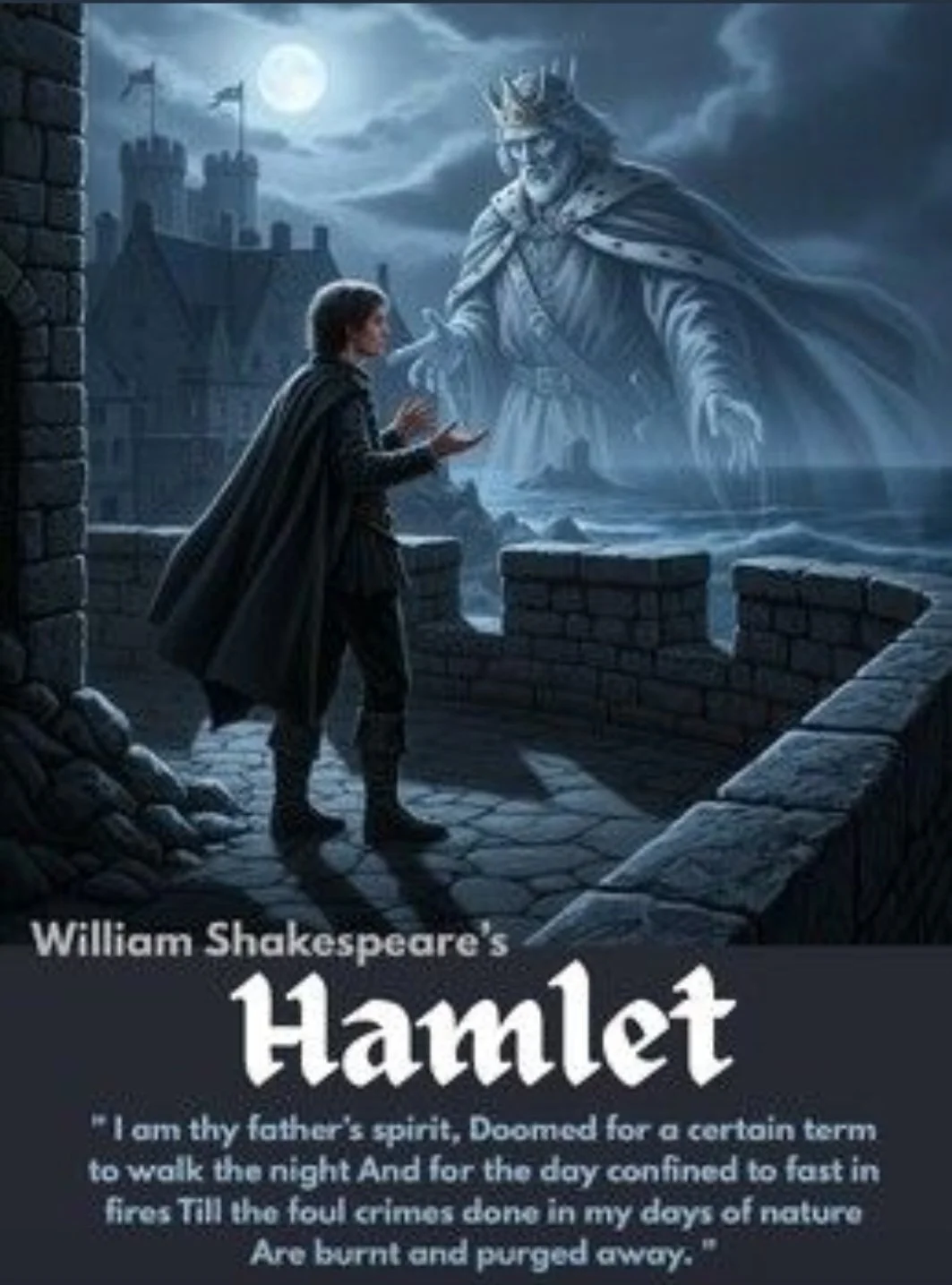Get Thee to a Nunnery… Adapted from Shakespeare’s Hamlet – Part I of IV
Preface / Epigraph
“Like most people, the first Shakespeare play I encountered was Romeo and Juliet. It’s practically a rite of passage in American schools, often introduced in ninth grade, exploring themes of youthful passion and tragic fate. Naturally, I gravitated toward it, perhaps hoping it might impress someone special. But as I delved deeper into Shakespeare’s works—King Lear, King Richard III, and A Midsummer Night’s Dream—I discovered layers of scholarship, history, and culture that went far beyond teenage curiosity. Understanding these plays illuminates Western culture, its legends, and its lore, a field I’ve long explored through composing short poems and short stories. Reading and truly understanding Shakespeare began as a way to connect with someone, but it quickly morphed into something more: an artistic sensibility, a rhythm of expression, a body language and presence that, apparently, many people—especially women—notice, in ways that other men naturally want to emulate. Then came Hamlet. At first, the title seemed unremarkable, almost like a city built on ham. Yet once I immersed myself in it, I saw the profound brilliance of Shakespeare’s architecture, poetry, and insight into human nature.”
From the first encounter with Romeo and Juliet, like most people, I was drawn into Shakespeare’s world—not just out of curiosity, but also with the hope of impressing someone special. As I explored King Lear, King Richard III, and A Midsummer Night’s Dream, that initial fascination deepened into a genuine appreciation for the scholarship, culture, and legend embedded in these works. Then came Hamlet, and with it, the line that echoes through the ages: “Get thee to a nunnery… for women… may not be honest.”
At first glance, it might read as harsh or cynical, but in context—after his mother’s marriage to Claudius—it reveals heartbreak, self-protection, and the complexity of human emotion. Hamlet’s tragedy, his indecision, and his poetic reflections, like “To be, or not to be”, contrast sharply with the playful, whimsical chaos of A Midsummer Night’s Dream, highlighting Shakespeare’s mastery in portraying the full spectrum of human experience.
Hamlet – Brief Synopsis / Cheat Sheet
Beginning: Prince Hamlet mourns his father, King Hamlet, and struggles with his mother Gertrude’s quick marriage to Claudius, the late king’s brother. The ghost of King Hamlet reveals the truth: Claudius murdered him and commands Hamlet to seek revenge.
Rising Action: Hamlet wrestles with moral and existential dilemmas, feigns madness, tests loyalties, and contemplates life, death, and human nature.
Climax: Misunderstandings and impulsive acts—including the accidental killing of Polonius—spiral into tragedy. Ophelia descends into madness.
Resolution: The final duel leaves Hamlet, Claudius, Gertrude, and Laertes dead. Fortinbras arrives to claim the throne, leaving Denmark in reflection.
Key Characters
Hamlet: Prince of Denmark; deeply philosophical, indecisive yet morally conscious.
King Hamlet / Ghost: Hamlet’s father; his appearance drives the action.
Queen Gertrude: Hamlet’s mother; her remarriage sparks Hamlet’s emotional turmoil.
Claudius: Hamlet’s uncle; murderer of King Hamlet and new king.
Polonius: Advisor to Claudius; father of Laertes and Ophelia; killed by Hamlet.
Laertes: Polonius’s son; foil to Hamlet; seeks revenge.
Ophelia: Polonius’s daughter; Hamlet’s love interest; driven to madness.
Key Themes & Lines
“Get thee to a nunnery, for women may not be honest”
Contextualized after Gertrude’s marriage, this line reflects Hamlet’s heartbreak and distrust of romantic relationships—not misogyny.
Functions as a “breakup line” and reveals his emotional self-protection.
Triggers Ophelia’s emotional collapse, illustrating human vulnerability under emotional pressure.
“To be, or not to be”
Condensed, poetic expression of Hamlet’s inner crisis.
Explores life, death, and the moral weight of action.
Captures the psychological pressure and human vulnerability that make the play timeless.
Highlights Hamlet’s deep reflection on existence, choice, and consequence.
Mental & emotional depth
Hamlet illustrates how grief, betrayal, and moral conflict can create acute psychological crises.
Shakespeare captures the human mind under extreme pressure, which is why the play remains timeless.
Connecting Hamlet and
A Midsummer Night’s Dream
While Hamlet and A Midsummer Night’s Dream appear dramatically different, a close look reveals subtle yet meaningful connections. Both explore human emotion and desire, though one does so through tragedy and moral introspection, and the other through comedy and whimsical mischief. Hamlet’s struggles with Ophelia mirror, in intensity if not in tone, the entangled romances of Midsummer, highlighting misunderstandings, longing, and the consequences of choices. Both plays also probe illusion versus reality: Hamlet navigates deceit, feigned madness, and hidden motives, while Midsummer blurs the line between magic and waking life. This juxtaposition underscores Shakespeare’s genius in portraying the full spectrum of human experience, showing that even works as distinct as these can illuminate common truths about desire, decision, and perception.
Reflection / Analysis Section (end of Part I)
Shakespeare’s brilliance is evident both in architectural integrity and poetic depth. The plays allow readers to explore human nature, love, morality, and the consequences of action. Hamlet demonstrates that literary study can shape artistic sensibility, expressive presence, and personal development, providing qualities others naturally admire and even emulate. Whether one sees divine inspiration or pure genius, the work’s richness invites endless interpretation, and drawing connections across Shakespeare’s diverse works reveals both the breadth and depth of his insight into the human condition.
“Hamlet Relationship Web”
HAMLET — haunted by his father’s ghost
│
├── OPHELIA — torn between love and obedience
│ └── POLONIUS — her father, the King’s adviser
│
└── CLAUDIUS — the usurper king, Hamlet’s uncle
└── GERTRUDE — Hamlet’s mother, caught between worlds


